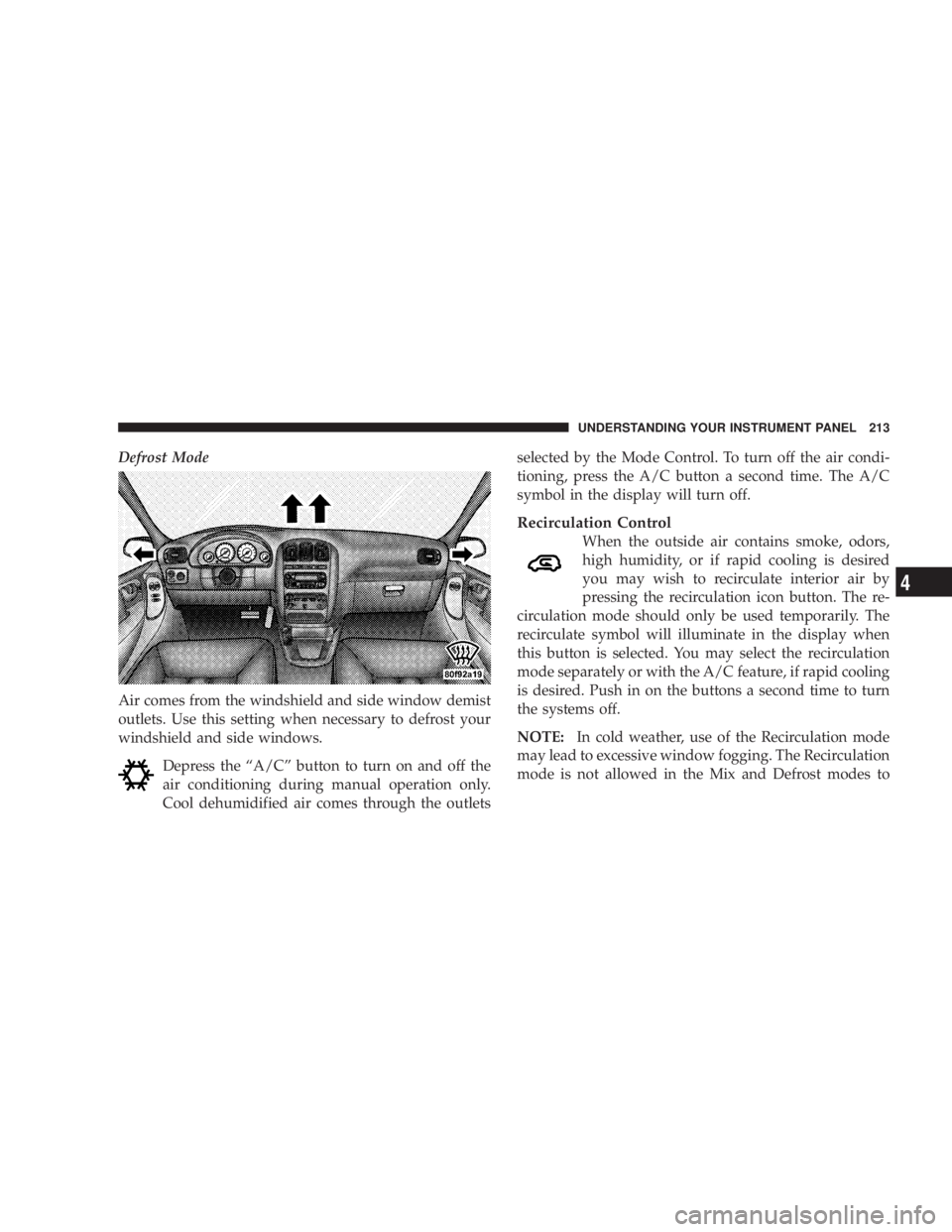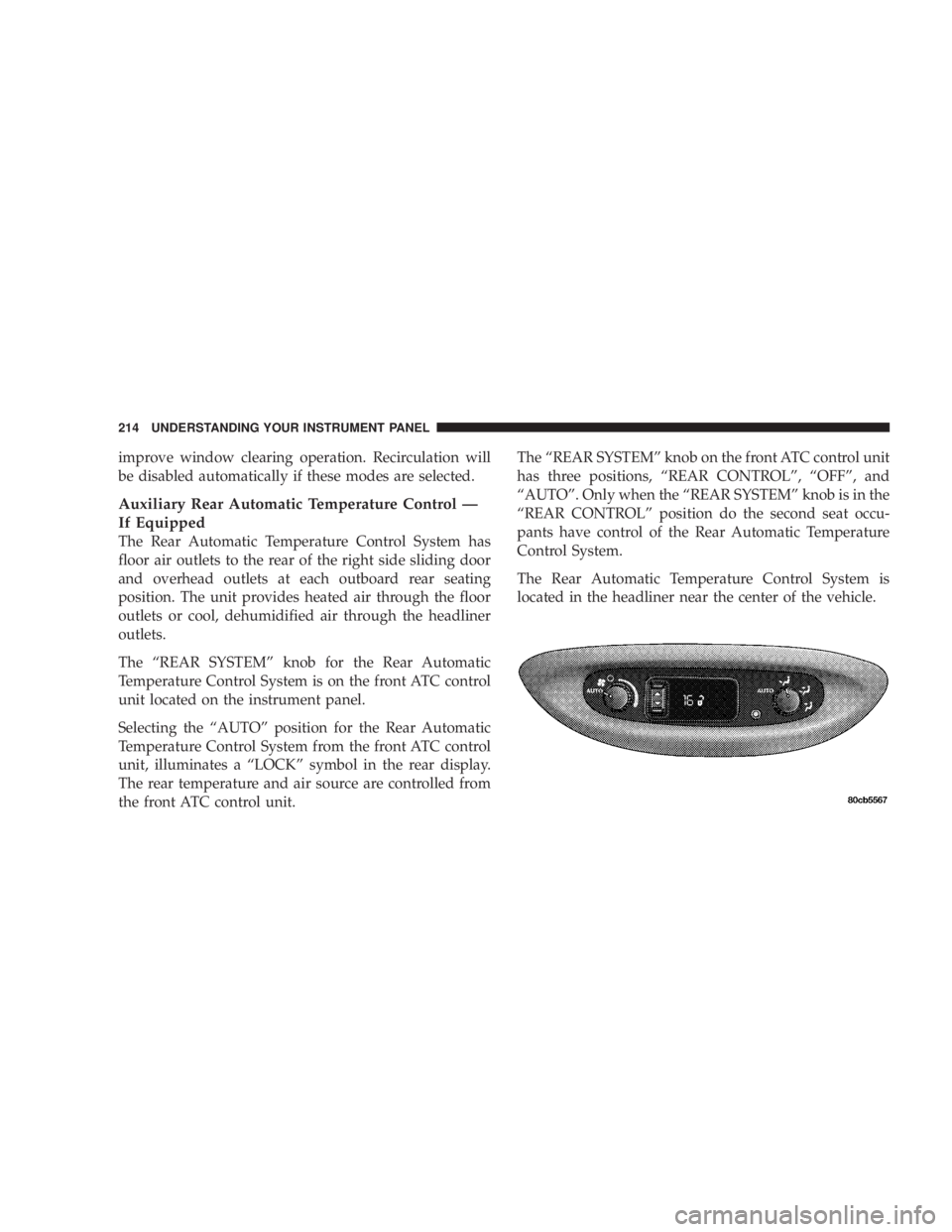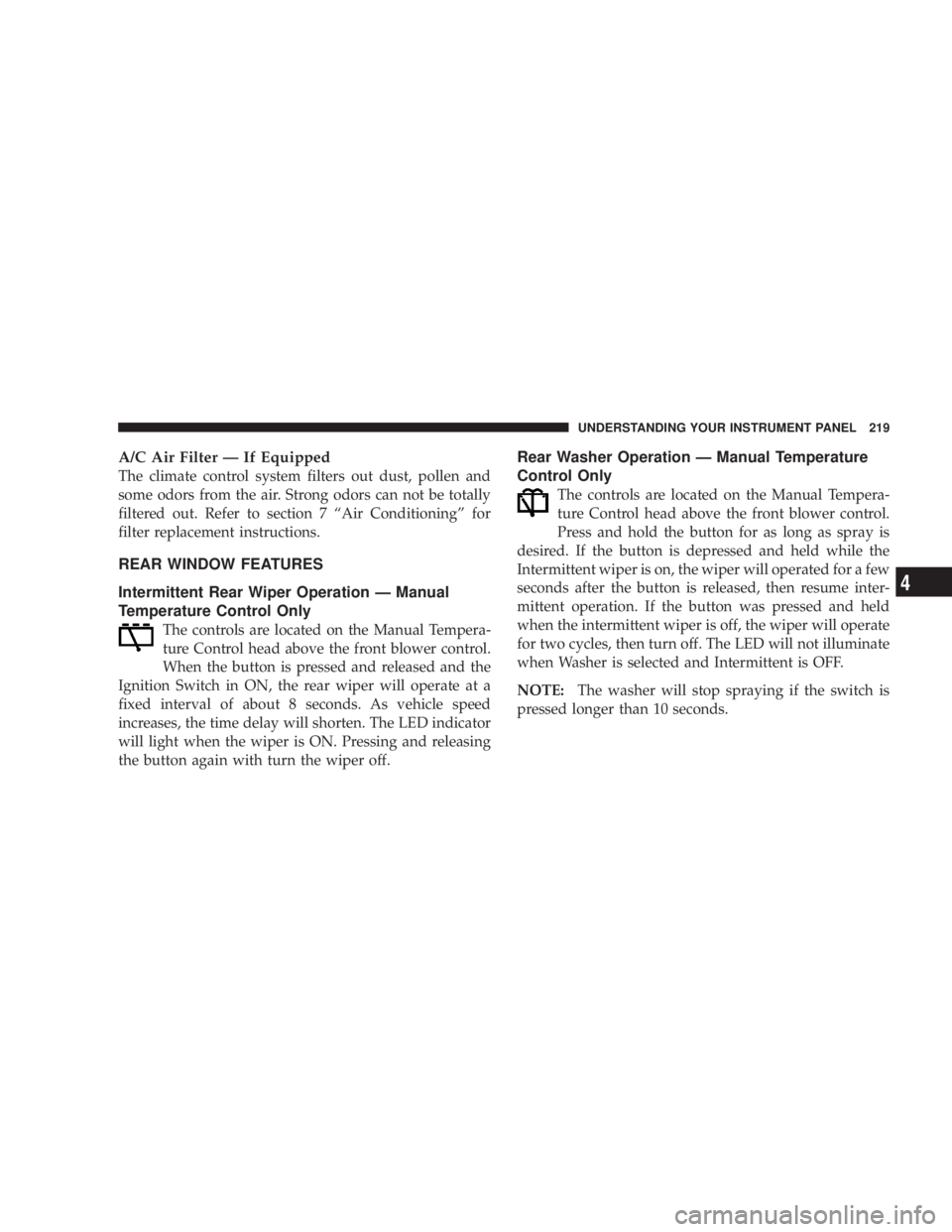Page 213 of 397

Defrost Mode
Air comes from the windshield and side window demist
outlets. Use this setting when necessary to defrost your
windshield and side windows.
Depress the ªA/Cº button to turn on and off the
air conditioning during manual operation only.
Cool dehumidified air comes through the outlets selected by the Mode Control. To turn off the air condi-
tioning, press the A/C button a second time. The A/C
symbol in the display will turn off.
Recirculation Control
When the outside air contains smoke, odors,
high humidity, or if rapid cooling is desired
you may wish to recirculate interior air by
pressing the recirculation icon button. The re-
circulation mode should only be used temporarily. The
recirculate symbol will illuminate in the display when
this button is selected. You may select the recirculation
mode separately or with the A/C feature, if rapid cooling
is desired. Push in on the buttons a second time to turn
the systems off.
NOTE: In cold weather, use of the Recirculation mode
may lead to excessive window fogging. The Recirculation
mode is not allowed in the Mix and Defrost modes to UNDERSTANDING YOUR INSTRUMENT PANEL 213
4
Page 214 of 397

improve window clearing operation. Recirculation will
be disabled automatically if these modes are selected.
Auxiliary Rear Automatic Temperature Control Ð
If Equipped
The Rear Automatic Temperature Control System has
floor air outlets to the rear of the right side sliding door
and overhead outlets at each outboard rear seating
position. The unit provides heated air through the floor
outlets or cool, dehumidified air through the headliner
outlets.
The ªREAR SYSTEMº knob for the Rear Automatic
Temperature Control System is on the front ATC control
unit located on the instrument panel.
Selecting the ªAUTOº position for the Rear Automatic
Temperature Control System from the front ATC control
unit, illuminates a ªLOCKº symbol in the rear display.
The rear temperature and air source are controlled from
the front ATC control unit. The ªREAR SYSTEMº knob on the front ATC control unit
has three positions, ªREAR CONTROLº, ªOFFº, and
ªAUTOº. Only when the ªREAR SYSTEMº knob is in the
ªREAR CONTROLº position do the second seat occu-
pants have control of the Rear Automatic Temperature
Control System.
The Rear Automatic Temperature Control System is
located in the headliner near the center of the vehicle.214 UNDERSTANDING YOUR INSTRUMENT PANEL
Page 217 of 397

Bi-Level Mode
Air comes from both the headliner outlets and the
floor outlets.
NOTE: In many temperature positions, the bi-level
mode is designed to provide cooler air out of the head-
liner outlets and warmer air from the floor outlets.
Headliner Mode
Air comes from the outlets in the headliner. Each of
these outlets can be individually adjusted to direct
the flow of air. Moving the air vane knob on the outlets to
one side will shut off the air flow.
Summer Operation
The engine cooling system in air conditioned vehicles
must be protected with a high-quality antifreeze coolant
to provide proper corrosion protection and to protect
against engine overheating. A 50% solution of ethylene glycol antifreeze coolant in water is recommended. Refer
to section 7, Maintenance Procedures, of this manual for
proper coolant selection.
Winter Operation
The air from the heater system will heat faster in cold
weather if you use only low blower speeds for the first 10
minutes of vehicle operation. Use of the air Recirculation
mode during winter months is not recommended be-
cause it may cause window fogging.
Vacation Storage
Anytime you store your vehicle, or keep it out of service
(i.e. vacation) for two weeks or more, run the air condi-
tioning system at idle for about five minutes in the fresh
air and high blower setting. This will insure adequate
system lubrication to minimize the possibility of com-
pressor damage when the system is started again. UNDERSTANDING YOUR INSTRUMENT PANEL 217
4
Page 218 of 397
Window Fogging
Vehicle windows tend to fog on the inside in mild rainy
or humid weather. To clear the windows, use the A/C,
PANEL and blower controls. Direct the panel outlets
toward the side windows. Do not use the Recirculation
mode without A/C for long periods as fogging may
occur.
Interior fogging on the windshield can be quickly re-
moved by using the defrost mode.
Outside Air Intake
Make sure the air intake, located directly in front of the
windshield, is free of obstructions such as leaves. Leaves
collected in the air intake may reduce airflow and if they
enter the plenum they could plug the water drains. In
winter months make sure the air intake is clear of ice,
slush and snow. Operating Tips218 UNDERSTANDING YOUR INSTRUMENT PANEL
Page 219 of 397

A/C Air Filter Ð If Equipped
The climate control system filters out dust, pollen and
some odors from the air. Strong odors can not be totally
filtered out. Refer to section 7 ªAir Conditioningº for
filter replacement instructions.
REAR WINDOW FEATURES
Intermittent Rear Wiper Operation Ð Manual
Temperature Control Only
The controls are located on the Manual Tempera-
ture Control head above the front blower control.
When the button is pressed and released and the
Ignition Switch in ON, the rear wiper will operate at a
fixed interval of about 8 seconds. As vehicle speed
increases, the time delay will shorten. The LED indicator
will light when the wiper is ON. Pressing and releasing
the button again with turn the wiper off. Rear Washer Operation Ð Manual Temperature
Control Only
The controls are located on the Manual Tempera-
ture Control head above the front blower control.
Press and hold the button for as long as spray is
desired. If the button is depressed and held while the
Intermittent wiper is on, the wiper will operated for a few
seconds after the button is released, then resume inter-
mittent operation. If the button was pressed and held
when the intermittent wiper is off, the wiper will operate
for two cycles, then turn off. The LED will not illuminate
when Washer is selected and Intermittent is OFF.
NOTE: The washer will stop spraying if the switch is
pressed longer than 10 seconds. UNDERSTANDING YOUR INSTRUMENT PANEL 219
4
Page 221 of 397

Rear Washer Operation Ð Automatic
Temperature Control Only
Press and hold the button as long as spray is
desired. If the switch is depressed while the wipers
are on, the wipers will operate for a few seconds
after the switch is released then resume the previously set
mode of intermittent wiper or continuous wipe. If the
switch is depressed when the wipers are off, the wipers
will operate for two cycles, then turn off.
NOTE: The washers will stop spraying if the switch is
pressed longer than 10 seconds.
Adding Washer Fluid
The fluid reservoir for the windshield washers and the
rear window washer is shared. It is located in the front of
the engine compartment on the passenger side and
should be checked for fluid level at regular intervals. Fill the reservoir with windshield washer solvent (not radia-
tor antifreeze) and operate the system for a few seconds
to flush out the residual water.
The washer fluid reservoir will hold a full gallon of fluid
when the Low Washer Fluid Light illuminates. UNDERSTANDING YOUR INSTRUMENT PANEL 221
4
Page 222 of 397
Electric Rear Window Defroster Ð If Equipped
Press this button to turn on the rear window
defroster and the optional heated mirrors. A light
will show that the defroster is on. The defroster automati-
cally turns off after about 10 minutes of operation.
If your vehicle is equipped with Infrared Three-Zone
Automatic Temperature Control the rear defroster sym-
bol will show in the display screen when the rear
window defroster is on. CAUTION!To avoid damaging the electrical conductors of the
rear window defroster, do not use scrapers, sharp
instruments, or abrasive window cleaners on the
interior surface of the window.
Labels can be peeled off after soaking with warm
water.222 UNDERSTANDING YOUR INSTRUMENT PANEL
Page 236 of 397
Park position. To release the parking brake, pull out on
the parking brake release located on the left side of the
instrument panel.
When parking on a hill, it is important to set the parking
brake before placing the gear selector in Park, otherwise
the load on the transmission locking mechanism may
make it difficult to move the selector out of park. As an added precaution, turn the front wheels toward the curb
on a downhill grade and away from the curb on a uphill
grade.
The parking brake should always be applied when the
driver is not in the vehicle.
WARNING!Leaving children in a vehicle unattended is danger-
ous for a number of reasons. A child or others could
be injured. Children should be warned not to touch
the parking brake, brake pedal or the gear selector
lever. Don't leave the keys in the ignition. A child
could operate power windows, other controls, or
move the vehicle.236 STARTING AND OPERATING